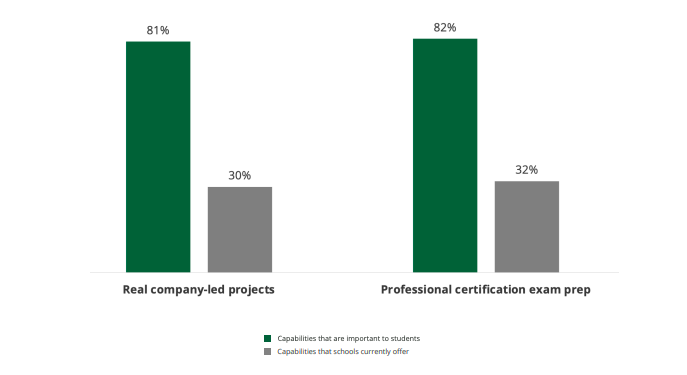Why Are Students Disengaged
A new survey by Wiley finds that one-fourth of students said they would be more invested in their courses if they learned in a way that emulated their future careers. Why Are Students Disengaged?
Undergraduate students are struggling to stay engaged in class—and they believe that material more directly connected to real-life issues could help solve the problem.
That’s a key finding of the recent State of the Student 2022 survey by the academic publishing company Wiley, which noted that 55 percent of undergraduate and 38 percent of graduate students said they struggle to remain interested in their classes. The same proportion of undergraduates and 34 percent of graduate students also said they have trouble retaining the material they learn.
The survey of 5,258 students and 2,452 instructors in North America was conducted in August 2022 and sought to understand the factors that most impact student success, as well as what factors instructors perceive as the most impactful.
Relate to Future Careers
Students cited one clear way professors could make them more interested in the material: by relating it more closely to their future careers. One-fourth of the students surveyed suggested that lessons with real-world applications, including those grounded in experiential learning, would improve their engagement.
Smita Bakshi, Wiley’s senior vice president of academic learning, said the findings apply to all fields. A professor in a STEM classroom, for instance, might introduce the actual tools or programs that a professional would use, she said, while a philosophy professor could link a lesson in ethics to current events, such as the debate over using ChatGPT as an educational tool.
A whopping 81 percent of students also said that it’s important or very important for institutions to incorporate company-led projects to mimic real-world work. Yet only 30 percent of institutions currently offer such projects, according to the report.
A graph of how many students want company-led projects and professional certification exam prep incorporated into their college courses, versus how many institutions offer those things. (Source: Wiley)
Real World Experience
Jillian Kinzie, associate director for Indiana University’s Center for Postsecondary Research and the National Survey of Student Engagement, said that students have long been interested in incorporating more real-world experience into their learning, but it can pose a challenge to professors for several reasons.
“You have to know who those contacts are, and if you don’t have them because you’re not working in the industry regularly, it takes a lot of time to secure the involvement of those people,” said Kinzie, who noted that the survey’s results largely mirror the results of the National Survey of Student Engagement.
And even if faculty have the contacts, industry professionals rarely have enough time to work with faculty and students, she said.
“There’s a dance you have to do to figure out how you’re going to make this work,” she said. “Both sides don’t have a lot of time to do that.”
Bakshi said she believes part of the reason experiential learning and real-world problem-solving can help students better engage with the material is because they show students how the course will actually aid them in their future careers. More and more, she said, parents and students alike are asking faculty and administrators what skills are most essential and what fields students should study to have the best chance of making it in today’s competitive job market.
“It is difficult to engage in a classroom setting when you’re not quite sure what that classroom experience is going to do to help you get that job,” she said.
At the same time, it’s not always easy for students to gain experience outside the classroom; 34 percent of those surveyed said they found it difficult to get an internship.
External Challenges
The lack of experiential learning isn’t the only thing keeping students from paying attention in class. They also reported high levels of financial and emotional stress; nearly half of undergraduates said mental health is a “challenge they’re facing in their educational journey.”
Because they have so much on their minds, Bakshi said, “they’re not bringing their whole self to the classroom.”
Another source of stress for some students is uncertainty about their careers. More students reported being unsure about what field to pursue in this survey (21 percent) than when Wiley last asked the question in 2021 (9 percent). The percentage of students looking to change their major also increased.
According to the survey, the main factors driving students toward a particular major were their interest in the field (57 percent), career opportunities (46 percent) and their ability to make a positive impact in that field (41 percent).
That contradicts what instructors tend to believe about the majors students choose; the report notes that professors think that students care more than they actually do about finding a high-paying job and less than they actually do about making a positive impact with their work.
Instructors are also more likely than students to see their institutions as doing a good job preparing graduates for the professional world; 64 percent of instructors and only 46 percent of students said their institution is preparing students well.
They also have disparate perceptions of what skills students will find most challenging postgraduation; students were most concerned that they would lack job skills (29 percent) while instructors expressed the most worry about their time management skills (47 percent).
Bakshi said it was important for professors to be aware of the areas in which students feel deficient so they can help address those concerns in the classroom.
“It’s really important then for educators … to be aware of how [students’] futures are being threatened,” she said. “Hopefully studies like this can close some of that awareness gap.”
Source:
Tanner Garrity
Tanner is the Senior Editor at InsideHook. His writing covers a wide range of verticals and topics, including wellness, longevity, mental health, environmental sustainability, urban planning, workplace trends, social issues, running and baseball.
https://www.insidehighered.com/news/2023/02/13/fight-student-disengagement-real-world-projects-can-help#.Y-qMt2TKzvE.link
Why Are Students Disengaged
https://www.techedmagazine.com/category/news-by-industry/


